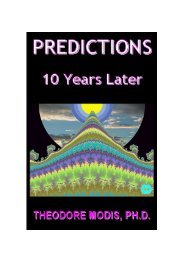There's more to volatility than volume - Santa Fe Institute
There's more to volatility than volume - Santa Fe Institute
There's more to volatility than volume - Santa Fe Institute
Create successful ePaper yourself
Turn your PDF publications into a flip-book with our unique Google optimized e-Paper software.
privately, there are no published quotes. Transaction prices in the off-book market are<br />
published only after they are completed. Most (but not all) of our analysis for the LSE is<br />
based on the on-book market.<br />
The on-book market is a fully au<strong>to</strong>mated electronic exchange. Market participants have<br />
the ability <strong>to</strong> view the entire limit order book at any instant, and <strong>to</strong> place trading orders<br />
and have them entered in<strong>to</strong> the book, executed, or canceled almost instantaneously. Though<br />
prices and quotes are completely transparent, the identities of parties placing orders are kept<br />
confidential, even <strong>to</strong> the two counter parties in a transaction. The trading day begins with<br />
an opening auction. There is a period of 10 minutes leading up <strong>to</strong> the opening auction<br />
when orders may be placed or cancelled without transactions taking place, and without any<br />
information about <strong>volume</strong>s or prices. The market is then cleared and for the remainder<br />
of the day (except for rare exceptions) there is a continuous auction, in which orders and<br />
cancellations are entered asynchronously and result in immediate action. For this study we<br />
ignore the opening and closing auctions and analyze only orders placed during the continuous<br />
auction.<br />
The off-book market (SEAQ) is very similar <strong>to</strong> the upstairs market in the NYSE. The<br />
main difference is that there is no physical gathering place, so transactions are arranged<br />
entirely via telephone. There are also several other minor differences, e.g. regarding the<br />
types of allowed transactions and the times when trades need <strong>to</strong> be reported. For example,<br />
a trade in the off-book market can be an ordinary trade, with a fixed price that is agreed<br />
on when the trade is initiated, or it can be a VWAP trade, where the price depends on the<br />
<strong>volume</strong> weighted average price, which is not known at the time the trade is arranged. In<br />
the latter case the trade does not need <strong>to</strong> be reported until the trade is completed. In such<br />
cases delays of a day or <strong>more</strong> between initiation and reporting are not uncommon.<br />
For the NYSE we use the Trades and Quotes (TAQ) data set. This contains the prices,<br />
times, and <strong>volume</strong> of all transactions, as well as the best quoted prices <strong>to</strong> buy or sell and<br />
the number of shares available at the best quotes at the times when these quotes change.<br />
Transaction prices from the upstairs and downstairs markets are mixed <strong>to</strong>gether and it is<br />
not possible <strong>to</strong> separate them. Our analysis in the NYSE is based on transaction prices,<br />
though we have also experimented with using the average price of the best quotes. For the<br />
15 minute time scale and the heavily traded s<strong>to</strong>cks that we study in this paper this does not<br />
seem <strong>to</strong> make very much difference.<br />
The data set for the LSE contains every order and cancellation for the on-book exchange,<br />
and a record of all transactions in both the on-book and off-book exchanges. We are able<br />
<strong>to</strong> separate the on-book and off-book transactions. The on-book transactions have the advantage<br />
that the timing of each trade is known <strong>to</strong> the nearest second, whereas as already<br />
mentioned, the off-book transactions may have reporting delays. Also the on-book transactions<br />
are recorded by a computer, whereas the off-book transactions depend on human<br />
records and are <strong>more</strong> error prone. Because of these problems, unless otherwise noted, we use<br />
only the downstairs prices. Our analysis for the LSE is based entirely on mid-quote prices<br />
in the on-book market, defined as the average of the best quote <strong>to</strong> buy and the best quote<br />
<strong>to</strong> sell.<br />
To simplify our analysis we paste the time series for each day <strong>to</strong>gether, omitting any price<br />
changes that occur outside of the period of our analysis, i.e. when the market is closed. For<br />
the NYSE we omit the first few and last few trades, but otherwise analyze the entire trading<br />
day, whereas for the LSE we omit the first and last half hour of each trading day. We don’t<br />
find that this makes very much difference – except as noted in Section IV C, our results are
















